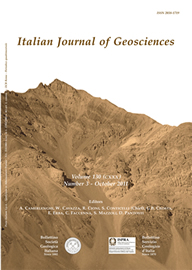
New insights from recently migrated CROP multichannel seismic data at the outermost Calabrian arc accretionary wedge (Ionian sea)
Vera Valenti(*)
(*) Dipartimento di Geologia e Geodesia, via Archirafi, 20 - 90100 Palermo. E-mail address: valv@unipa.it
Volume: 130 (2011) f.3
Pages: 330-342
Abstract
This study addresses selected aspects of the stratigraphic-structural setting of the outermost Calabrian Arc accretionary wedge and underlines relationships between structural development and Messinian evaporite stratigraphy through the analysis of re-processed CROP multichannel seismic reflection profiles.
A detailed seismostratigraphic analysis, calibrated with P-velocities compiled by previous works, images a general bipartition of the Messinian evaporite deposits: the transparent «lower subunit» appears to have undergone ductile-flow deformation», with the development of salt-cored thrusting structures, and the layered «upper subunit» appears to be characterized by brittle deformation.
The difference in both the seismic facies and the deformational style imaged for the Messinian evaporite unit allows a better defined unit stratigraphy that consists of a salt layer below and a gypsum and marl layer above.
Lateral variations in composition and/or thickness of the Messinian evaporites are the local cause of the replacement of the transparent and layered subunits with a more chaotic facies as well as a change in the deformation style, with the development of doubleverging imbricated thrust sheets of the whole Messinian sequence.
Most of the accreted outermost accretionary wedge is imaged to have resulted from the progressive piling up and associated thrusting of the Messinian evaporites and overlying Plio-Quaternary sediments; the gently dipping-reflector located at the base of the Messinian evaporites shows negative polarity at some places, suggesting that it acts as the décollement level.
Active deformation occurs on the outermost accretionary wedge as related to subduction-driven shortening; further on, near-surface gravitational slide tectonics is imaged as related to a growing outermost wedge and favoured by the salt tectonics and/or to fluid overpressuring on the décollement level.
Keywords
Get Full Text